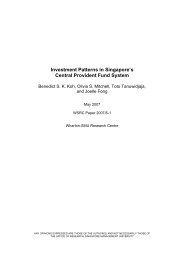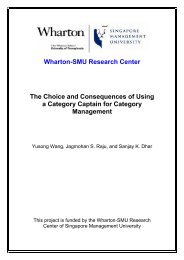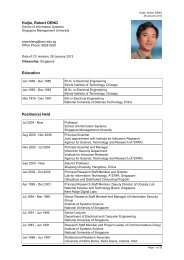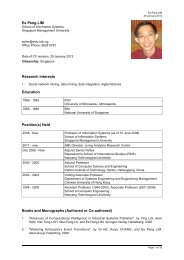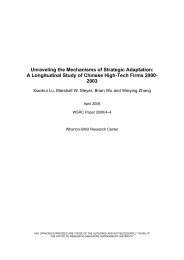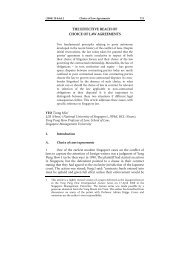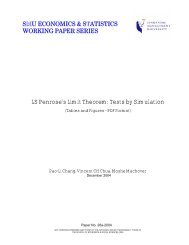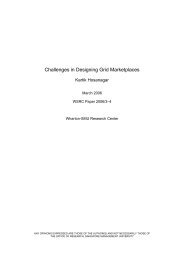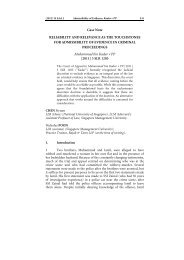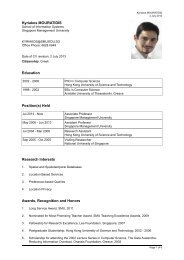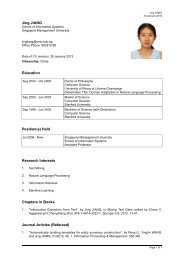The Benefits of Volume-Conditional Order-Crossing - Singapore ...
The Benefits of Volume-Conditional Order-Crossing - Singapore ...
The Benefits of Volume-Conditional Order-Crossing - Singapore ...
You also want an ePaper? Increase the reach of your titles
YUMPU automatically turns print PDFs into web optimized ePapers that Google loves.
Also, because their expected utility <strong>of</strong> deviating from the conjectured equilibrium by placing an<br />
order in the conditional market is<br />
E ũj | ˜rj = r H<br />
= (1 − ˆm)(−c) + ˆm(−rH)<br />
and r H > r L ≥ c, they prefer using the continuous market when ˆm is close enough to one (larger<br />
than ˆm H, say). Because p ≥ r L, if it is the case that a > p, then we will know that neither the<br />
informed traders nor the patient hedgers would consider using the continuous market. Notice from<br />
(A.4) that a is smaller than 2κ<br />
λ and can be made arbitrarily close to it by setting ˆm to a large<br />
enough value. Thus it is the case that a > p as long as ˆm ≥ ˆmI for some ˆmI ∈ (0, 1). Finally,<br />
we know from Lemma 4.1 that patient traders can coexist in the conditional market as long as<br />
(15) is satisfied, or equivalently, as long as ˆm = 2ψ n[p−(rL−c)]<br />
1−λ ≥ (1−λ)(rL−c) ≡ ˆm L. <strong>The</strong>refore, as long as<br />
ˆm = max <br />
ˆm H, ˆm I, ˆm L ∈ (0, 1), impatient hedgers trade in the continuous market while patient<br />
hedgers and informed traders use the conditional market, and so the volume condition can be<br />
set to ψ = 1−λ<br />
2 ˆm. Patient hedgers and informed traders are clearly better <strong>of</strong>f since they did not<br />
trade before the conditional market opened, as shown in Proposition 4.1. Impatient hedgers are<br />
also better <strong>of</strong>f as the ask price in the continuous market is now lower than 2κ<br />
λ , the ask price that<br />
prevailed in the equilibrium <strong>of</strong> Proposition 4.1.<br />
Pro<strong>of</strong> <strong>of</strong> Proposition 5.1<br />
To attract the patient hedgers to the conditional market, the specialist must set c to a value<br />
not exceeding r L. Let us pick any c ∈ [0, r L]. As in the pro<strong>of</strong> <strong>of</strong> Proposition 3.2, if only the patient<br />
hedgers use the conditional market, this market clears with probability 1 − ˆm, where ˆm = 2ψ<br />
1−λ (see<br />
(A.1)). <strong>The</strong> equilibrium must have the impatient hedgers trade in the continuous market, so that<br />
it must be the case that ˆm ≥ a−c<br />
rH−c<br />
as in the pro<strong>of</strong> <strong>of</strong> Proposition 3.2. Increasing ˆm above a−c<br />
rH−c<br />
reduces the probability that the conditional market clears and does not affect how a is set in the<br />
continuous market or the equilibrium strategies <strong>of</strong> traders. As such, doing so only serves to reduce<br />
the revenues that the specialist can expect to collect from the conditional market. Thus, for any<br />
equilibrium value <strong>of</strong> a and c, it will be the case that ˆm is set equal to a−c<br />
rH−c ≡ ˆma,c.<br />
<strong>The</strong> specialist sets a and c in order to maximize his expected pr<strong>of</strong>its, which are given by (A.3)<br />
with ˆm replaced by ˆma,c, that is,<br />
E λ<br />
˜π MM = a<br />
2 + c(1 − λ)1 − ˆm2 a,c<br />
− κ. (A.8)<br />
2<br />
In equilibrium, a must not exceed rH (for the impatient traders to use the continuous market), and<br />
so it is easy to verify that ˆma,c is decreasing in c. In turn, this implies that E <br />
˜π MM is increasing<br />
31



